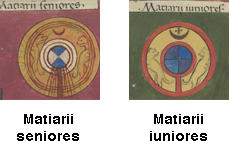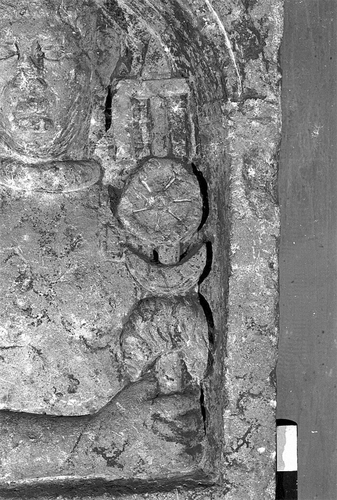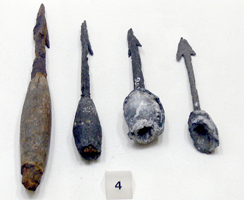
This page created 29 March 2014, and last modified: 21 November 2015 (Iulius Pancuius photo added)

In the eastern half of the empire, the senior-most unit of the legiones palatina listed (12.16 in Ingo Maier's numbering scheme) under the command of the second Master of the Soldiers in the Imperial Presence (i.e the Magister Militum Praesentalis II) is the Matiarii seniores. Its shield pattern (10#2) as shown in various manuscripts, under the label (10.b) Matiarii seniores (O, P, M) or Martiarii seniores (W, B), is as below:

The pattern has a yellow rim (orange in W) and a yellow main field (white in M) separated from the rim by three (two in B) thin lines. The boss is quartered blue (faded in M) and white (yellow in M; light blue in B), and encircled by a first white band (yellow in M) which is in turn encircled by a second yellow band (white in P, B; orange in W). A large number of thin black rays (absent in B) emanate downwards from the boss; in W, the gaps between then are filled in with orange, unlike O, P and M, in which the background is visible through them; O and P however do fill in the central ones with black, giving something of the impression of a pillar, and thus resembling the very mnay other "keyhole"-shaped designs in the Notitia, such as that of the Batavi seniores (9.24). The main field is decorated with a small black (red in W, yellow in M, P) crescent at the 12 o'clock position, oriented points upwards. Two quadrupeds (absent in W) flank the boss, heads turned inwards, depicted as line drawings; they appear to be some sort of feline, or possibly canid. The shield pattern is thus similar in design to that of the Matiarii iuniores (9.22) under the command of the first Master of the Soldiers in the Imperial Presence, as these patterns taken from the Paris manuscript show:

Both feature a yellow ground, a crescent at the top, and two animals turning their heads toward each other. The fine rays (?) of the seniores seen in all four of the manuscript versions (but not in the Froben printed edition, B) appear to be unique in the Notitia. The motif of an upturned crescent at the top of the shield is found in other shield patterns depicted in the Notitia (e.g. the Batavi seniores, 9.24, under the Magister Militum Praesentalis I), and goes back at least far as Trajan's time, as several examples can be found on Trajan's column. Upturned crescents also appear as motifs found on units' standards, usually near the base, under round discs, and thus probably symbolising a sun-moon combination. An example from an auxiliary unit is shown to the right. The name Matiarii might have something to do with Mars directly; but given the pairing of the units Matiarii and Lanciarii (see below), it is more likely to have come by a more indirect route, from mattiobarbuli - the lead-weighted throwing darts (Vegetius 1.17) with which infantrymen were equipped. These were also known as plumbatae, from their lead weights, and as martiobarbuli; the latter meaning "Mars' little barbs". In either case, a derivation based on Legio I Martia or Legio IIII Martia is unlikely. |
 A tombstone from Neuss (Novaesium) belonging to Iulius Pancuius of the cohors Lusitanorum. Photo by M.C. Bishop, and used under CCA 2.0 license. |

"The" Lanciarii and Mat(t)iarii are found brigaded together not only in Ammianus (e.g. 21.13.16; 31.13.8), but also in a fragment (FGH IV,6) of Eutychianus of Cappadocia, cited by the 6th century Byzantine chronicler Malalas, describing Julian's Persian expedition. When the Matiarii was split into seniores and iuniores units is unknown, but it is interesting to note that in the Notitia it is the Lanciarii iuniores (12.21) that is in the same command as the Matiarii seniores, while the Matiarii iuniores (9.22) is in the same command as the Lanciarii seniores (9.17), and that neither pairing corresponds to two adjacently-ranked units. I would suggest that this seems to imply that the two iuniores units had been relatively recently swapped between the two commands when the Notitia was compiled. Note also that the most senior of the legiones comitatenses listed under the Magister Militum per Illyricum is called the Matiarii constantes (21.15); it would appear that the name Matiarii seems to have been used only for senior units, unlike Lanciarii.
1. Ingo Maier; "Appendix 4: Numeration of the new edition of the compilation 'notitia dignitatum' (Cnd)"; last accessed 26 October 2015. See also for here for numbering examples. Return
2. Ammianus Marcellinus ("Ammianus"); "Res gestae a fine Corneli Taciti"; available here in Latin and here in English (last accessed 21 November 2015). Return
3. Carl Muller & Antonie Jean Letronne (ed.); "Fragmenta Historicum Graecorum"; vol. 4, Paris, A.F. Didot (1851), at p 5; available here (last accessed 21 November 2015). Return

Return to the Notitia alphabetical unit list page.
Return to my Notitia index page.